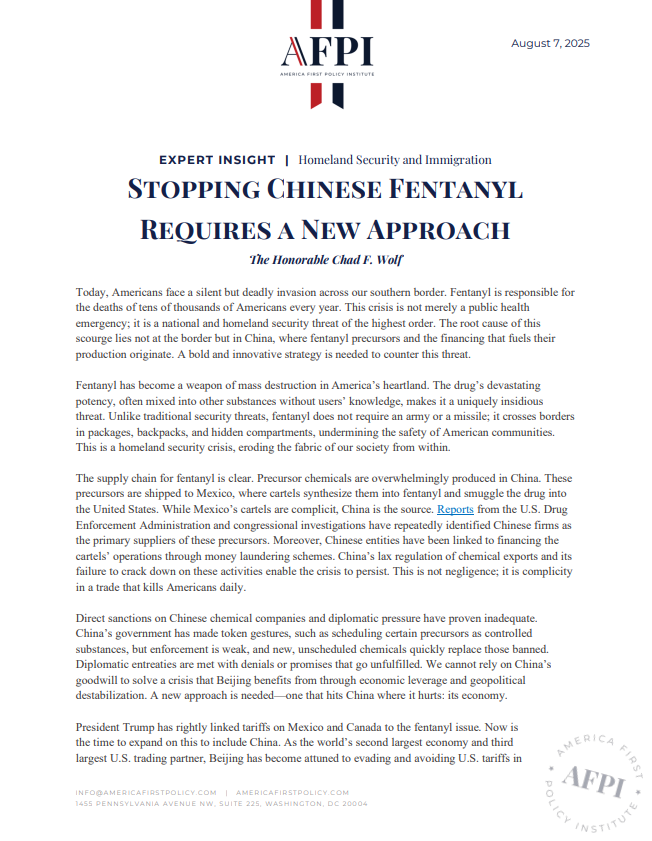Stopping Chinese Fentanyl Requires a New Approach
Today, Americans face a silent but deadly invasion across our southern border. Fentanyl is responsible for the deaths of tens of thousands of Americans every year. This crisis is not merely a public health emergency; it is a national and homeland security threat of the highest order. The root cause of this scourge lies not at the border but in China, where fentanyl precursors and the financing that fuels their production originate. A bold and innovative strategy is needed to counter this threat.
Fentanyl has become a weapon of mass destruction in America’s heartland. The drug’s devastating potency, often mixed into other substances without users’ knowledge, makes it a uniquely insidious threat. Unlike traditional security threats, fentanyl does not require an army or a missile; it crosses borders in packages, backpacks, and hidden compartments, undermining the safety of American communities. This is a homeland security crisis, eroding the fabric of our society from within.
The supply chain for fentanyl is clear. Precursor chemicals are overwhelmingly produced in China. These precursors are shipped to Mexico, where cartels synthesize them into fentanyl and smuggle the drug into the United States. While Mexico’s cartels are complicit, China is the source. Reports from the U.S. Drug Enforcement Administration and congressional investigations have repeatedly identified Chinese firms as the primary suppliers of these precursors. Moreover, Chinese entities have been linked to financing the cartels’ operations through money laundering schemes. China’s lax regulation of chemical exports and its failure to crack down on these activities enable the crisis to persist. This is not negligence; it is complicity in a trade that kills Americans daily.
Direct sanctions on Chinese chemical companies and diplomatic pressure have proven inadequate. China’s government has made token gestures, such as scheduling certain precursors as controlled substances, but enforcement is weak, and new, unscheduled chemicals quickly replace those banned. Diplomatic entreaties are met with denials or promises that go unfulfilled. We cannot rely on China’s goodwill to solve a crisis that Beijing benefits from through economic leverage and geopolitical destabilization. A new approach is needed—one that hits China where it hurts: its economy.
President Trump has rightly linked tariffs on Mexico and Canada to the fentanyl issue. Now is the time to expand on this to include China. As the world’s second largest economy and third largest U.S. trading partner, Beijing has become attuned to evading and avoiding U.S. tariffs in the past. However, the imposition of a pollution tariff tied to environmental standards could change that. China’s industrial sector, which produces fentanyl precursors, is heavily polluting, relying on dirty power plants and lax environmental regulations to keep costs low. A pollution tariff could impose duties on Chinese goods based on the environmental impact of their production, effectively raising the cost of China’s exports to the United States. This approach has several advantages as a national security tool.
First, a pollution tariff would be difficult to evade, if properly constructed. China often evades targeted sanctions on specific companies or industries by rerouting shipments or renaming firms. In contrast, a pollution tariff is more effective because it applies even when goods are transshipped through other high-polluting countries—most of which still emit more than the U.S.
Fentanyl precursor production is part of this ecosystem, reliant on the same energy-intensive, polluting infrastructure as other Chinese manufacturing. By taxing imported goods based on their pollution, the United States can indirectly raise the cost of producing and exporting precursor chemicals, squeezing the profitability of these illicit operations.
Second, a U.S. pollution tariff could motivate our allies to get tough on China too. With the U.S. moving first to address China’s pollution, we can work to create a coalition of likeminded countries to not only address the fentanyl crisis but also isolate China at a crucial moment diplomatically. China, the world’s largest polluter, would face significant pressure to reform its industrial practices or lose access to the lucrative U.S. market, and the markets of our allies. This dual-purpose policy strengthens America’s strategic position, both from an environment and security perspective.
Third, a pollution tariff aligns with broader U.S. interests. For decades, China’s lax environmental enforcement has allowed unfair competition, undercutting American manufacturers and hollowing out once-thriving industrial towns. A pollution tariff would level the playing field for American workers, who uphold the highest environmental standards, by compelling Chinese firms to either raise their standards and production costs or pay at the U.S. border. This policy would advance the fair competition that President Trump has championed, helping to restore economic vitality in struggling communities and offering young Americans a future free from the despair that has driven too many toward substance abuse.
The tariff could be based on verifiable metrics, with rates escalating until China demonstrates improvement. Revenue from the tariff could fund border security enhancements, directly addressing the crisis at home.
The fentanyl crisis is a national and homeland security crisis that demands unconventional solutions. China’s role as the source of fentanyl precursors and financing makes it a primary culprit, and a pollution tariff offers a powerful, evasive-resistant tool to impose costs on Beijing. Decisive action is necessary to protect the American homeland.
